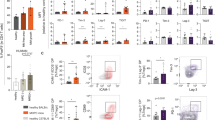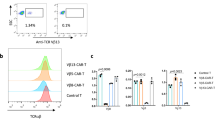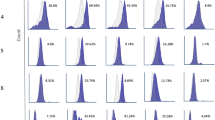Abstract
Multiple myeloma causes approximately 10% of all hematologic malignancies. We have previously shown that human T cells expressing chimeric NKG2D receptors (chNKG2D) consisting of NKG2D fused to the CD3ζ cytoplasmic domain secrete proinflammatory cytokines and kill human myeloma cells. In this study, we show chNKG2D T cells are effective in a murine model of multiple myeloma. Mice with established 5T33MM–green fluorescent protein tumors were treated with one or two infusions of chNKG2D T cells. Compared with mice treated with T cells expressing wild type (wt)NKG2D receptors, a single dose of chNKG2D T cells increased survival, with half of the chNKG2D T-cell-treated mice surviving long term. Two infusions of chNKG2D T cells led to tumor-free survival in all mice. ChNKG2D T cells were located at sites of tumor growth, including the bone marrow and spleen after intravenous injection. There was an increase in activated host T cells and NK cells at tumor sites and in serum interferon-γ after chNKG2D T-cell injection. Surviving mice were able to resist a rechallenge with 5T33MM cells but not RMA lymphoma cells, indicating that the mice developed a protective, specific memory response. These data demonstrate that chNKG2D T cells may be an effective adoptive cellular therapy for multiple myeloma.
This is a preview of subscription content, access via your institution
Access options
Subscribe to this journal
Receive 12 print issues and online access
$259.00 per year
only $21.58 per issue
Buy this article
- Purchase on Springer Link
- Instant access to full article PDF
Prices may be subject to local taxes which are calculated during checkout






Similar content being viewed by others
References
Blade J, Bladé J, Rosiñol L, Cibeira MT, Rovira M, Carreras E et al. Hematopoietic stem cell transplantation for multiple myeloma beyond 2010. Blood 2010; 115: 3655–3663.
Rosenblatt J, Avigan D . Cellular immunotherapy for multiple myeloma. Best Pract Res Clin Haematol 2008; 21: 559–577.
Chiriva-Internati M, Cobos E, Kast WM . Advances in immunotherapy of multiple myeloma: from the discovery of tumor-associated antigens to clinical trials. Int Rev Immunol 2007; 26: 197–222.
Harrison SJ, Cook G . Immunotherapy in multiple myeloma--possibility or probability? Br J Haematol 2005; 130: 344–362.
Choi C, Witzens M, Bucur M, Feuerer M, Sommerfeldt N, Trojan A et al. Enrichment of functional CD8 memory T cells specific for MUC1 in bone marrow of patients with multiple myeloma. Blood 2005; 105: 2132–2134.
Yi Q, Osterborg A, Bergenbrant S, Mellstedt H, Holm G, Lefvert AK et al. Idiotype-reactive T-cell subsets and tumor load in monoclonal gammopathies. Blood 1995; 86: 3043–3049.
van Rhee F, Szmania SM, Zhan F, Gupta SK, Pomtree M, Lin P et al. NY-ESO-1 is highly expressed in poor-prognosis multiple myeloma and induces spontaneous humoral and cellular immune responses. Blood 2005; 105: 3939–3944.
Raitakari M, Brown RD, Gibson J, Joshua DE . T cells in myeloma. Hematol Oncol 2003; 21: 33–42.
Brown RD, Yuen E, Nelson M, Gibson J, Joshua D et al. The prognostic significance of T cell receptor beta gene rearrangements and idiotype-reactive T cells in multiple myeloma. Leukemia 1997; 11: 1312–1317.
Carbone E, Neri P, Mesuraca M, Fulciniti MT, Otsuki T, Pende D et al. HLA class I, NKG2D, and natural cytotoxicity receptors regulate multiple myeloma cell recognition by natural killer cells. Blood 2005; 105: 251–258.
Girlanda S, Fortis C, Belloni D, Ferrero E, Ticozzi P, Sciorati C et al. MICA expressed by multiple myeloma and monoclonal gammopathy of undetermined significance plasma cells costimulates pamidronate-activated gammadelta lymphocytes. Cancer Res 2005; 65: 7502–7508.
El-Sherbiny YM, Meade JL, Holmes TD, McGonagle D, Mackie SL, Morgan AW et al. The requirement for DNAM-1, NKG2D, and NKp46 in the natural killer cell-mediated killing of myeloma cells. Cancer Res 2007; 67: 8444–8449.
Okamoto M, Inaba T, Yamada N, Uchida R, Fuchida SI, Okano A et al. Expression and role of MHC class I-related chain in myeloma cells. Cytotherapy 2006; 8: 509–516.
Nausch N, Cerwenka A . NKG2D ligands in tumor immunity. Oncogene 2008; 27: 5944–5958.
Bryceson YT, Ljunggren HG . Tumor cell recognition by the NK cell activating receptor NKG2D. Eur J Immunol 2008; 38: 2957–2961.
Wu JY, Hill JM, Ernstoff MS, Meehan KR . The critical role of the NKG2D receptor in CD8+ CTL and CD8+CD56+NKT cell cytotoxicity. Blood 2004; 104: 865a.
Alici E, Konstantinidis KV, Sutlu T, Aints A, Gahrton G, Ljunggren HG et al. Anti-myeloma activity of endogenous and adoptively transferred activated natural killer cells in experimental multiple myeloma model. Exp Hematol 2007; 35: 1839–1846.
Soriani A, Zingoni A, Cerboni C, Iannitto ML, Ricciardi MR, Di Gialleonardo V et al. ATM-ATR dependent up-regulation of DNAM-1 and NKG2D ligands on multiple myeloma cells by therapeutic agents results in enhanced NK cell susceptibility and is associated with a senescent phenotype. Blood 2008; 113: 3503–3511.
Barber A, Zhang T, Megli CJ, Wu J, Meehan KR, Sentman CL et al. Chimeric NKG2D receptor-expressing T cells as an immunotherapy for multiple myeloma. Exp Hematol 2008; 36: 1318–1328.
Barber A, Zhang T, DeMars LR, Conejo-Garcia J, Roby KF, Sentman CL et al. Chimeric NKG2D receptor-bearing T cells as immunotherapy for ovarian cancer. Cancer Res 2007; 67: 5003–5008.
Zhang T, Barber A, Sentman CL . Chimeric NKG2D modified T cells inhibit systemic T-cell lymphoma growth in a manner involving multiple cytokines and cytotoxic pathways. Cancer Res 2007; 67: 11029–11036.
Radl J, De Glopper ED, Schuit HR, Zurcher C . Idiopathic paraproteinemia. II. Transplantation of the paraprotein-producing clone from old to young C57BL/KaLwRij mice. J Immunol 1979; 122: 609–613.
Manning LS, Berger JD, O'Donoghue HL, Sheridan GN, Claringbold PG, Turner JH et al. A model of multiple myeloma: culture of 5T33 murine myeloma cells and evaluation of tumorigenicity in the C57BL/KaLwRij mouse. Br J Cancer 1992; 66: 1088–1093.
Radl J, Croese JW, Zurcher C, Van den Enden-Vieveen MH, de Leeuw AM et al. Animal model of human disease. Multiple myeloma. Am J Pathol 1988; 132: 593–597.
Radl J . Age-related monoclonal gammapathies: clinical lessons from the aging C57BL mouse. Immunol Today 1990; 11: 234–236.
Dudley ME, Wunderlich JR, Yang JC, Sherry RM, Topalian SL, Restifo NP et al. Adoptive cell transfer therapy following non-myeloablative but lymphodepleting chemotherapy for the treatment of patients with refractory metastatic melanoma. J Clin Oncol 2005; 23: 2346–2357.
Gattinoni L, Finkelstein SE, Klebanoff CA, Antony PA, Palmer DC, Spiess PJ et al. Removal of homeostatic cytokine sinks by lymphodepletion enhances the efficacy of adoptively transferred tumor-specific CD8+ T cells. J Exp Med 2005; 202: 907–912.
Muranski P, Boni A, Wrzesinski C, Citrin DE, Rosenberg SA, Childs R et al. Increased intensity lymphodepletion and adoptive immunotherapy--how far can we go? Nat Clin Pract Oncol 2006; 3: 668–681.
Huang J, Khong HT, Dudley ME, El-Gamil M, Li YF, Rosenberg SA et al. Survival, persistence, and progressive differentiation of adoptively transferred tumor-reactive T cells associated with tumor regression. J Immunother 2005; 28: 258–267.
Dudley ME, Yang JC, Sherry R, Hughes MS, Royal R, Kammula U et al. Adoptive cell therapy for patients with metastatic melanoma: evaluation of intensive myeloablative chemoradiation preparative regimens. J Clin Oncol 2008; 26: 5233–5239.
Turk MJ, Guevara-Patiño JA, Rizzuto GA, Engelhorn ME, Sakaguchi S, Houghton AN et al. Concomitant tumor immunity to a poorly immunogenic melanoma is prevented by regulatory T cells. J Exp Med 2004; 200: 771–782.
Salem ML, Díaz-Montero CM, Al-Khami AA, El-Naggar SA, Naga O, Montero AJ et al. Recovery from cyclophosphamide-induced lymphopenia results in expansion of immature dendritic cells which can mediate enhanced prime-boost vaccination antitumor responses in vivo when stimulated with the TLR3 agonist poly(I:C). J Immunol 2009; 182: 2030–2040.
Alici E, Konstantinidis KV, Aints A, Dilber MS, Abedi-Valugerdi M et al. Visualization of 5T33 myeloma cells in the C57BL/KaLwRij mouse: establishment of a new syngeneic murine model of multiple myeloma. Exp Hematol 2004; 32: 1064–1072.
Barber A, Zhang T, Sentman CL . Immunotherapy with chimeric NKG2D receptors leads to long-term tumor-free survival and development of host antitumor immunity in murine ovarian cancer. J Immunol 2008; 180: 72–78.
Barber A, Sentman CL . Chimeric NKG2D T cells require both T cell- and host-derived cytokine secretion and perforin expression to increase tumor antigen presentation and systemic immunity. J Immunol 2009; 183: 2365–2372.
Barber A, Rynda A, Sentman CL . Chimeric NKG2D expressing T cells eliminate immunosuppression and activate immunity within the ovarian tumor microenvironment. J Immunol 2009; 183: 6939–6947.
Vanderkerken K, Asosingh K, Croucher P, Van Camp B . Multiple myeloma biology: lessons from the 5TMM models. Immunol Rev 2003; 194: 196–206.
Yaccoby S, Barlogie B, Epstein J . Primary myeloma cells growing in SCID-hu mice: a model for studying the biology and treatment of myeloma and its manifestations. Blood 1998; 92: 2908–2913.
Laronne-Bar-On A, Zipori D, Haran-Ghera N . Increased regulatory versus effector T cell development is associated with thymus atrophy in mouse models of multiple myeloma. J Immunol 2008; 181: 3714–3724.
Yang L, Edwards CM, Mundy GR . Gr-1+CD11b+ myeloid-derived suppressor cells: formidable partners in tumor metastasis. J Bone Miner Res 2010; 25: 1701–1706.
Manning LS, Chamberlain NL, Leahy MF, Cordingley FT . Assessment of the therapeutic potential of cytokines, cytotoxic drugs and effector cell populations for the treatment of multiple myeloma using the 5T33 murine myeloma model. Immunol Cell Biol 1995; 73: 326–332.
Frohn C, Höppner M, Schlenke P, Kirchner H, Koritke P, Luhm J et al. Anti-myeloma activity of natural killer lymphocytes. Br J Haematol 2002; 119: 660–664.
Wen YJ, Min R, Tricot G, Barlogie B, Yi Q et al. Tumor lysate-specific cytotoxic T lymphocytes in multiple myeloma: promising effector cells for immunotherapy. Blood 2002; 99: 3280–3285.
Pratt G, Goodyear O, Moss P . Immunodeficiency and immunotherapy in multiple myeloma. Br J Haematol 2007; 138: 563–579.
Cook G, Campbell JD, Carr CE, Boyd KS, Franklin IM et al. Transforming growth factor beta from multiple myeloma cells inhibits proliferation and IL-2 responsiveness in T lymphocytes. J Leukoc Biol 1999; 66: 981–988.
Cook G, Campbell JD . Immune regulation in multiple myeloma: the host-tumour conflict. Blood Rev 1999; 13: 151–162.
Joshua DE, Brown RD, Ho PJ, Gibson J . Regulatory T cells and multiple myeloma. Clin Lymphoma Myeloma 2008; 8: 283–286.
Gattinoni L, Powell Jr DJ, Rosenberg SA, Restifo NP . Adoptive immunotherapy for cancer: building on success. Nat Rev Immunol 2006; 6: 383–393.
Williams KM, Gress RE . Immune reconstitution and implications for immunotherapy following haematopoietic stem cell transplantation. Best Pract Res Clin Haematol 2008; 21: 579–596.
Tey SK, Bollard CM, Heslop HE . Adoptive T-cell transfer in cancer immunotherapy. Immunol Cell Biol 2006; 84: 281–289.
Bracci L, Moschella F, Sestili P, La Sorsa V, Valentini M, Canini I et al. Cyclophosphamide enhances the antitumor efficacy of adoptively transferred immune cells through the induction of cytokine expression, B-cell and T-cell homeostatic proliferation, and specific tumor infiltration. Clin Cancer Res 2007; 13: 644–653.
Gasser S, Orsulic S, Brown EJ, Raulet DH . The DNA damage pathway regulates innate immune system ligands of the NKG2D receptor. Nature 2005; 436: 1186–1190.
Nice TJ, Coscoy L, Raulet DH . Posttranslational regulation of the NKG2D ligand Mult1 in response to cell stress. J Exp Med 2009; 206: 287–298.
Jinushi M, Vanneman M, Munshi NC, Tai YT, Prabhala RH, Ritz J et al. MHC class I chain-related protein A antibodies and shedding are associated with the progression of multiple myeloma. Proc Natl Acad Sci USA 2008; 105: 1285–1290.
Zhang T, Lemoi BA, Sentman CL . Chimeric NK-receptor-bearing T cells mediate antitumor immunotherapy. Blood 2005; 106: 1544–1551.
Acknowledgements
We thank Karin Vanderkerken for the 5T33MM tumor cells, Gary Ward and Alice Givan at the Englert Cell Analysis Laboratory for assistance with flow cytometry (Norris Cotton Cancer Center, Lebanon, NH, USA), and the Animal Resource Center at Dartmouth Medical School for help with the animal studies. We also thank Randy Noelle for helpful comments on the study design and paper. This work was supported in part by grants from the Norris Cotton Cancer Center at Dartmouth Medical School, Department of Microbiology and Immunology, and National Institutes of Health (CA130911, T32 AI07363, P20 RR16437 (KRM)). The contents are solely the responsibility of the authors and do not necessarily represent the official views of the NIH.
Author information
Authors and Affiliations
Corresponding author
Ethics declarations
Competing interests
The technology described in this paper is licensed by Celdara Medical, LLC. Dr Sentman and Celdara are developing the technology for clinical use. If they are successful, Dr Sentman will receive compensation. This arrangement is under compliance with the policies of Dartmouth College.
Rights and permissions
About this article
Cite this article
Barber, A., Meehan, K. & Sentman, C. Treatment of multiple myeloma with adoptively transferred chimeric NKG2D receptor-expressing T cells. Gene Ther 18, 509–516 (2011). https://doi.org/10.1038/gt.2010.174
Received:
Revised:
Accepted:
Published:
Issue Date:
DOI: https://doi.org/10.1038/gt.2010.174
Keywords
This article is cited by
-
Biomarkers as targets for CAR-T/NK cell therapy in AML
Biomarker Research (2023)
-
A bispecific CAR-T cell therapy targeting BCMA and CD38 in relapsed or refractory multiple myeloma
Journal of Hematology & Oncology (2021)
-
Novel CAR T therapy is a ray of hope in the treatment of seriously ill AML patients
Stem Cell Research & Therapy (2021)
-
NKG2D-CAR-transduced natural killer cells efficiently target multiple myeloma
Blood Cancer Journal (2021)
-
T cells expressing NKG2D chimeric antigen receptors efficiently eliminate glioblastoma and cancer stem cells
Journal for ImmunoTherapy of Cancer (2019)



